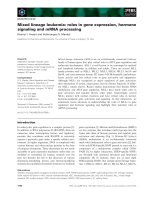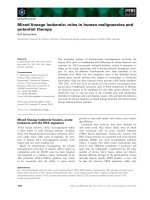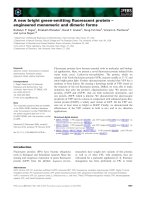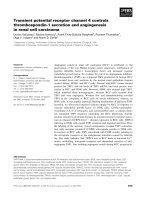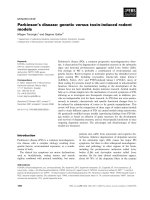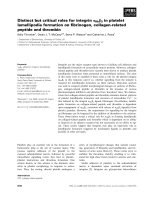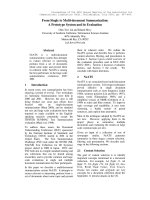Báo cáo khoa học: Huntington’s disease: roles of huntingtin-interacting protein 1 (HIP-1) and its molecular partner HIPPI in the regulation of apoptosis and transcription pptx
Bạn đang xem bản rút gọn của tài liệu. Xem và tải ngay bản đầy đủ của tài liệu tại đây (227.57 KB, 9 trang )
MINIREVIEW
Huntington’s disease: roles of huntingtin-interacting
protein 1 (HIP-1) and its molecular partner HIPPI in the
regulation of apoptosis and transcription
Nitai P. Bhattacharyya, Manisha Banerjee and Pritha Majumder*
Crystallography and Molecular Biology Division and Structural Genomics Section, Saha Institute of Nuclear Physics, Kolkata, India
Huntington’s disease (HD, OMIM 143100) is an auto-
somal dominant progressive neurodegenerative disease
caused by the expansion of polymorphic CAG (coding
for glutamine) repeats beyond 36 at exon 1 of the
huntingtin (htt) gene, localized at chromosome 4p16.3.
Age at onset (AO) of the disease varies widely
(1–90 years, mean 35 years). There is an inverse cor-
relation between AO and expanded CAG repeat
numbers, but it is not the only determinant of
variation in AO [1]. HD is fatal within 10–15 years
after appearance of the first symptom. The symptoms
include uncontrolled movement, emotional distur-
bances, psychiatric abnormalities, cognitive deficits,
and dementia. The gene htt encodes a protein [hunting-
tin (Htt), 348 kDa] with a polyglutamine stretch
starting from the 18th amino acid. Also, two proline-
rich regions adjacent to the polyglutamine domain and
several HEAT repeats, known to be involved in
Keywords
apoptosis; HIP-1; HIPPI; huntingtin-
interacting proteins; transcription
Correspondence
N. P. Bhattacharyya, Crystallography and
Molecular Biology Division and Structural
Genomics Section, Saha Institute of Nuclear
Physics, 1 ⁄ AF Bidhan Nagar, Kolkata
700 064, India
Fax: +91 033 23374637
Tel: +91 033 23375345–49 (5 lines),
ext. 1301
E-mail: or
*Present address
Roswell Park Cancer Institute, Cell Stress
Biology Department, Buffalo, New York,
USA
(Received 29 February 2008, revised 15
May 2008, accepted 18 June 2008)
doi:10.1111/j.1742-4658.2008.06563.x
Huntingtin protein (Htt), whose mutation causes Huntington’s disease
(HD), interacts with large numbers of proteins that participate in diverse
cellular pathways. This observation indicates that wild-type Htt is involved
in various cellular processes and that the mutated Htt alters these processes
in HD. The roles of these interacting proteins in HD pathogenesis remain
largely unknown. In the present review, we present evidence that Htt-inter-
acting protein 1 (HIP-1), an endocytic protein, together with its interacting
partner HIPPI, regulates apoptosis and gene expression, both processes
being implicated in HD. Further studies are necessary to establish whether
the HIPPI–HIP-1 complex or other interacting partners of HIPPI regulate
apoptosis and gene expression that are relevant to HD.
Abbreviations
ANTH, AP180 N-terminal homology domain; AO, age at onset; AP, adaptor protein; AR, androgen receptor; BLOC1S2, biogenesis of
lysosome-related organelles complex-1 subunit 2; CLH1, clathrin heavy chain 1; CLH2, clathrin heavy chain 2; CLTA, clathrin light chain A;
CLTB, clathrin light chain B; ENTH, Epsin N-terminal homology; HD, Huntington’s disease; HIP-1, huntingtin-interacting protein 1; HIPPI,
huntingtin-interacting protein 1 interactor; Htt, huntingtin protein; NMDAR, N-methyl-
D-aspartate receptor; pDED, pseudo-death effector
domain; Shh, Sonic hedgehog.
FEBS Journal 275 (2008) 4271–4279 ª 2008 The Authors Journal compilation ª 2008 FEBS 4271
protein–protein interactions, are present at the N-ter-
minal region of the protein. Wild-type Htt is localized
at the endoplasmic reticulum, Golgi complex, mito-
chondria, and synaptic vesicles. Htt is ubiquitously
expressed, although the neurodegeneration caused by
the mutated Htt shows region specificity [2,3].
The expanded polyglutamine domain of mutant Htt
is highly self-associative, resulting in aggregates ⁄ neuro-
nal intranuclear inclusions. Aggregates ⁄ neuronal intra-
nuclear inclusions are observed in cell models, brains
of transgenic animals, and post-mortem brains of HD
patients [2]. Aggregate formation is enhanced with the
increase in the number of glutamines in vitro and
in vivo, and is believed to cause neurodegeneration [4].
Although a contradictory finding, that visible aggre-
gates are protective to neurons, has also been made
[5]. The autosomal dominant nature of the disease sug-
gests a toxic gain-of-function of the mutated protein
that disrupts normal cellular functions and causes
neuronal death [3]. Loss-of-function of the wild-type
protein may also contribute, at least partially, to the
disease pathology [6]. Over the years, various cellular
events, such as excitotoxicity, oxidative stress, mito-
chondrial dysfunction, stress in the endoplasmic reticu-
lum, formation of channels through membranes,
axonal transport, protein degradation, autophagy,
transcriptional dysregulation, and apoptosis, have been
implicated in HD. These processes may not be inde-
pendent of each other. Detailed descriptions of these
processes are beyond the scope of this review. In
the present review, we specifically focus on the role of
Htt-interacting protein HIP-1 and its molecular part-
ner HIPPI in the regulation of apoptosis and transcrip-
tion, the two processes that are altered in HD [7,8].
HIP-1 – its interacting partners and
endocytosis
Large numbers of proteins have been identified, by
different techniques that interact with Htt [9–11].
These studies reveal that Htt may function as a
scaffold and coordinate diverse cellular functions [9–
13]. Some of the Htt-interacting proteins also alter the
pathogenicity in the Drosophila model of HD [13].
Among 300 Htt-interacting proteins described so
far, HIP-1 is one of the most studied. The possible
involvement of HIP-1 in various cancers has been
reviewed recently [14] and will not be discussed here.
HIP-1 has been shown by yeast two-hybrid assays to
interact with N-terminal Htt. HIP-1 is orthologous to
yeast Sla2p, which is known to be involved in endocy-
tosis and regulation of the actin cytoskeleton. HIP-1
and Htt colocalize in neuronal cells [15,16]. The inter-
action of HIP-1 with wild-type Htt is stronger than
that observed with mutated Htt [17]. In addition to
Htt, HIP-1 interacts with its paralog HIP1-R, subunits
of clathrin-associated adaptor protein (AP) complex
AP2A1 and AP2A2, clathrin heavy chain 1 (CLH1),
and clathrin heavy chain 2 (CLH2), clathrin light
chain A (CLTA), and clathrin light chain B (CLTB),
and N-methyl-d-aspartate receptor (NMDAR) subun-
its NR2A and NR2B. Various domains, such as the
AP180 N-terminal homology domain (ANTH), also
known as the Epsin N-terminal homology (ENTH)
domain, the central coiled-coil region and a C-terminal
talin homology domain are present at HIP-1. The
coiled-coil domain contains a leucine-zipper motif and
mediates heterodimerization with HIP-1R. Consensus
binding sites for the endocytic adaptor protein AP2
(DPF motif), clathrin heavy chain (LMDMD clathrin-
box motif) and a phosphatidylinositol 4,5-biphosphate-
binding motif at its ANTH ⁄ ENTH domain are also
present [14,18]. Various domains of HIP-1 are shown
in Fig. 1. Direct evidence that HIP-1 is involved in
endocytosis comes from HIP-1 knock-out (HIP-1
) ⁄ )
)
mice, which show defects in assembly of endocytic
protein complexes on liposomal membranes and
a-amino-3-hydroxy-5-methyl-4-isoxazolepropionic acid
receptor trafficking [19]. The similarities in amino acid
sequences and domains between HIP-1, HIP-1R and
yeast ortholog Sla2p, the interacting partners of HIP-1
with known functions and results with knockout mice
Fig. 1. Various domains of HIP-1. The ANTH ⁄ ENTH domain (38–160), coiled-coil domain (371–610), and talin-like domain (814–1112) were
predicted with the
SMART tool ( Binding sites for HIPPI (422–503), AP2 (262–266 and 358–360), CLH1, CLH2
(332–336), CLTA, CLTB (484–489) and other domains are taken from the published literature and mentioned in the text. The positions of the
amino acids are not to scale.
HIP-1 & HIPPI mediated apoptosis and transcription N. P. Bhattacharyya et al.
4272 FEBS Journal 275 (2008) 4271–4279 ª 2008 The Authors Journal compilation ª 2008 FEBS
show that HIP-1 participates in the regulation of
cytoskeletal and endocytic processes.
HIP-1 and its interacting partners –
roles in apoptosis and survival
Various pathways followed during apoptosis have been
reviewed recently [20]. In the ‘extrinsic pathway’, acti-
vation of caspase-8 ⁄ caspase-10, mostly through trans-
membrane death receptors, leads to activation of
downstream caspase-3 and cleavage of other down-
stream substrates, leading to nucleosomal ladders, a
hallmark of apoptosis. In the ‘intrinsic pathway’,
signal factors released from mitochondria activate
caspase-9 and then caspase-3, leading to cell death.
These two pathways may crosstalk via caspase-8-medi-
ated cleavage of Bid. In the caspase-independent path-
way, apoptosis-inducing factors or endonuclease G,
normally present in the mitochondria, are released and
translocated to the nucleus, where they cleave the
genome into nucleosomal ladders directly.
Several experimental findings indicate that HIP-1 is
a proapoptotic protein. Exogenous expression of HIP-
1 in neuronal and non-neuronal cells induces apoptosis
following the intrinsic pathway [17,21]. The pseudo-
death effector domain (pDED) of HIP-1 (Fig. 1) alone
is able to induce apoptosis; Phe398 of HIP-1 (within
the pDED) is critical for increased apoptosis. Coex-
pression of wild-type N-terminal Htt (encoded by
exon 1 of htt) and HIP-1 reduces HIP-1-induced apop-
tosis [17,21]. Wild-type N-terminal Htt, being able to
interact with HIP-1 strongly, may reduce the amount
of HIP-1 that is available to interact with other pro-
tein(s) and reduce apoptosis. In rat cells, HIP-1 is
cleaved in response to drugs that are known to induce
apoptosis, as well as in cells expressing exogenous
HIP-1, although the relevance of such cleavages in
apoptosis remains unknown. HIP-1 interacts directly
with procaspase-9 and activates it. Direct interaction
of HIP-1 with Apaf1 increases recruitment of cyto-
chrome c to the apotosome complex, resulting in
increased apoptosis [21]. Depending on the status of
phosphorylation of HIP-1 by Dyrk1, HIP-1 interacts
with caspase-3 and enhances apoptosis, in a condition
where interaction and phosphorylation of HIP-1 by
Dyrk1 are reduced [22].
Exogenous expression of HIPPI (HIP-1 protein
interactor), a molecular partner of HIP-1, increases
apoptosis through the extrinsic pathway. The HIP-1–
HIPPI heterodimer recruits procaspase-8 and activates
it [23]. Enhancement of apoptosis by exogenous HIPPI
in the presence of endogenous HIP-1 is mediated
through activation of caspase-8, caspase-1, caspase-9 ⁄
caspase-6, and caspase-3. Cleavage of Bid and release
of cytochrome c and apoptosis-inducing factors from
the mitochondria are also observed. Coexpression of
wild-type htt exon 1 and Hippi decreases apoptosis and
increases survival in comparison with that obtained in
cells expressing Hippi only. In such a condition, inter-
action of HIPPI with HIP-1 is reduced. This result fur-
ther shows that freely available HIP-1 is necessary to
induce apoptosis [24].
Contradictory findings that HIP-1 may act as a
prosurvival ⁄ antiapoptotic protein and may not influ-
ence apoptosis at all are also available. Expression of
full-length HIP-1 does not increase apoptosis, whereas
deletion of the N-terminal ANTH ⁄ ENTH domain
increases apoptosis [25]. Deletion of murine HIP-1
in vivo increases testicular degeneration by apoptosis,
indicating a protective role of HIP-1 in apoptosis [26].
Mice deficient in both HIP-1 and its paralog HIP-1R
exhibit neurodegeneration at adulthood and can be
rescued by human HIP-1 [27]. Reduced sperm count
and defects in reproduction have been observed in
HIP-1
) ⁄ )
mice, due to apparent loss of postmeiotic
spermatids [28]. These results show that HIP-1 in dif-
ferent conditions may act as an antiapoptotic protein.
Overexpression of HIP-1 in brain tumors is correlated
with the increased expression of epidermal growth
factor receptor and platelet-derived growth factor
b-receptor [29]. The ANTH ⁄ ENTH domain of HIP-1
interacts with 3-phosphate containing inositol lipids
and stabilizes the growth factor receptor tyrosine
kinases by increasing their half-life following ligand
induced endocytosis. Such interaction affects cell
growth and survival [30]. This observation supports
the contention that the ANTH⁄ ENTH domain of
HIP-1 protects cells from death by apoptosis, as
mentioned earlier [25]. Taken together, these results
show that HIP-1 may act as a prosurvival protein in
different conditions.
Contradictory results showing that HIP-1 is a proa-
poptotic protein [17,21–24] or an antiapoptotic protein
[25–30] in different conditions could be due to the
presence or absence of HIP-1-interacting partners. The
decrease in HIP-1–HIPPI-mediated apoptosis, either
by overexpression of Homer 1c, an interactor of HIP-
PI (for details see the next section), or by the wild-type
N-terminal Htt, which strongly interacts with HIP-1
[24,31], supports this contention. In such cases, the
amounts of freely available HIPPI or HIP-1 may
decrease, resulting in reduced apoptosis. Exogenous
expression of HIP-1 (cloned in pcDNA3 and kindly
provided to us by T. S. Ross, Department of Internal
Medicine, University of Michigan Medical School,
Ann Arbor, MI, USA) in HeLa cells, where endoge-
N. P. Bhattacharyya et al. HIP-1 & HIPPI mediated apoptosis and transcription
FEBS Journal 275 (2008) 4271–4279 ª 2008 The Authors Journal compilation ª 2008 FEBS 4273
nous HIPPI is undetectable [24], did not increase
apoptosis. However, in Neuro2A and K562 cells,
where endogenous HIPPI is present [24], exogenous
expression of HIP-1 increased apoptosis. Additionally,
expression of HIPPI in HeLa cells, where HIP-1 was
knocked down, decreased apoptosis (M. Banerjee and
N. P. Bhattacharyya, unpublished observations) rela-
tive to that obtained in HeLa cells with endogenous
HIP-1 [24]. The proapoptotic activity of HIPPI or
HIP-1 may thus be dependent on the presence or
absence of its interacting partner HIP-1 and HIPPI
respectively.
HIPPI and its interacting partners –
regulation of apoptosis
HIPPI, also known as estrogen-related receptor
b-like 1, is a homolog of Chlamydomonas intraflagellar
transport 57. HIPPI does not have any known domain
except a pDED and a myosin-like domain. Interaction
of HIPPI with HIP-1 takes place through the pDED,
specifically through 409 K, present in helix 5 of HIPPI,
although other regions have influence over such inter-
actions [23]. We mentioned above that HIP-1 and
HIPPI together induce apoptosis [23,24]. Identification
of additional proteins such as Homer1c ⁄ Homer1 [31],
BAR ⁄ BFAR [32], RybP [33], BLOC1S2 [34] and apop-
tin [35] that interact with HIPPI further indicates that
HIPPI may regulate apoptosis. Homer1c ⁄ Homer1
belongs to the homer family of proteins and is known
to participate, in neuronal signaling. HIPPI interacts
with Homer1c and colocalizes in the postsynaptic
region of hippocampus. It has been shown that
Homer1c completely abolishes HIP-1–HIPPI-mediated
apoptosis in striatal neurons, the specific region of
neuronal loss in HD [31]. The bifunctional apoptosis
inhibitor BAR, also known as BFAR, is expressed pre-
dominantly in neurons, and interacts with HIP-1 as
well as HIPPI. BAR inhibits neuronal apoptosis in
response to diverse stimuli [32]. It is not known
whether BAR can regulate HIP-1–HIPPI-mediated
apoptosis. Recently, Rybp has been shown to interact
with HIPPI and increase HIPPI-mediated apoptosis
through the caspase-8-mediated pathway. Rybp also
interacts with ubiquitin-binding protein, procaspase-8,
procaspase-10, and the HIPPI interactor apotin. Inter-
action of HIPPI with Rybp is involved in murine
neural development, although the significance of such
an interaction in apoptosis regulation or HD patho-
genesis remains elusive [33]. Apotin, a chicken anemia
virus-encoded protein, has been shown to colocalize
with HIPPI in the cytoplasm of normal cells, whereas
in tumor cells, they localize separately in the nucleus
and cytoplasm. The HIPPI–apoptin interaction may
suppress apoptosis [35]. The functional relevance of
such interactions in HIP-1- or HIPPI-mediated apop-
tosis also remains unknown. Biogenesis of lysosome-
related organelles complex-1 subunit 2 (BLOC1S2)
specifically interacts with HIPPI, but not with HIP-1.
Coexpression of HIPPI and BLOC1S2 does not increase
apoptosis but sensitizes apoptosis induction by stauro-
sporin or death ligand. In addition, the expression of
BLOC1S2 is increased in some tumors [34].
Information on the interacting partners of HIPPI
such as HIP-1, Homer 1c, BAR and apoptin
indicates that HIPPI may also be a proapoptotic
protein. Rybp, an interactor of HIPPI, interacts with
caspase-8 and caspase-10, indicating that HIPPI
might also be involved in the regulation of apoptosis.
Even though the exact function of HIPPI remains
unknown, knockout mice for Hippi (HIPPI
) ⁄ )
) exhi-
bit downregulation of the Sonic hedgehog (Shh)
pathway and developmental abnormalities [36].
However, the exact molecular defects in the Shh
pathway in HIPPI
) ⁄ )
mice are unknown. It may be
worthwhile to mention that Dyrk1, an HIP-1 inter-
actor, is also involved in the Shh pathway by regu-
lating Gli1 [37]. The specific role of the Shh pathway
in apoptosis or HD remains unknown.
Role of HIP-1 and HIPPI in
transcriptional regulation
There are not many reports on the transcriptional
activity of HIP-1 or HIPPI. It has been shown that
HIP-1 interacts with androgen receptor (AR) through
its coiled-coil domain and increases the transcriptional
activity of AR on known AR-inducible promoter.
Treatment with androgen increases the nuclear fraction
of AR as well as that of HIP-1, indicating that forma-
tion of the HIP-1–AR heterodimer is involved in trans-
location of AR to the nucleus. Facilitation of nuclear
transport of AR by HIP-1 depends on its C-terminal
nuclear localization signal for HIP-1. In addition to
that of AR, mediation of transcriptional activity of
genes by other nuclear hormone receptors, such as
estrogen and glucocorticoid receptors, is also enhanced
by HIP-1. All these results demonstrate a nonconven-
tional function of HIP-1 as a transcriptional regulator
[38], in addition to its endocytosis and proapoptotic or
prosurvival ⁄ antiapoptotic functions described in the
preceding sections.
The evidence that HIPPI directly or indirectly alters
gene expression comes from the observations that
caspase-1, caspase-3, caspase-7, caspase-8 and caspase-10
expression is increased in cells expressing exogenous
HIP-1 & HIPPI mediated apoptosis and transcription N. P. Bhattacharyya et al.
4274 FEBS Journal 275 (2008) 4271–4279 ª 2008 The Authors Journal compilation ª 2008 FEBS
Hippi. Also, expression of the mitochondrial-coded
genes ND1 and ND4, the nuclear genome-coded
mitochondrial genes SDHA and SDHB and the antia-
poptotic genes BCL-2 and survivin is decreased in
Hippi-expressing cells [24]. Decreased expression of
ND1, ND4, SDHA, SDHB and BCL-2 may cause
mitochondrial dysfunctions and contribute towards the
increased apoptosis by HIPPI as mentioned earlier.
Decreased expression of the antiapoptotic gene survivin
may also enhance apoptosis.
HIPPI interacts with the putative promoter of
caspase-1 in vitro and in vivo [39]. On the basis of
in vitro interactions of various mutants of the sequence
5¢-AAAGACATG-3¢ ()101 to )93) present at the
caspase-1 putative promoter sequence, where HIPPI can
bind, it has been predicted that HIPPI will interact with
AAAGA[GC][ATC][TG] [40]. The presence of other
sequence motifs around the HIPPI binding site where
transcription factors p53, p73 and ETS1 can bind and
influence the expression of caspase-1 [41–43] indicate
that these or other unknown transcription factors may
cooperate with HIPPI for the regulation of caspase-1
expression. HIPPI also interacts with putative promoter
sequences of caspase-8 and caspase-10 [40] and PARP-1
()579 to )149) (P. Majumder and N. P. Bhattacharyya,
unpublished results) in vitro. However, to determine
whether HIPPI binds with a similar motif present at the
putative promoters will require further studies. It will be
of interest to determine whether such a motif is also
present at the putative promoter regions of other genes,
especially those that are altered in HD models, as
observed in several high-throughput gene expression
studies [8], and investigate whether HIPPI alters the
expression of some of them.
It is not clear how HIPPI, being a cytoplasmic
protein, enters into the nucleus and interacts with the
putative promoter sequences and eventually increases
the expression of the genes. A similar mechanism to
that described above for AR translocation by HIP-1
[38] may also operate for HIPPI translocation. We are
presently investigating whether a similar mechanism of
translocation of HIPPI may take place, using HIP-1
knocked down or HIP-1 overexpressed cells. However,
indirect evidence that HIP-1 is necessary for the
increased expression of caspase-1 has been obtained.
Exogenous expression of Hippi and exon 1 of htt with
16 CAG repeats reduces the interaction of HIP-1 with
HIPPI and reduces apoptosis [24]. In such a condition,
expression of caspase-1 was decreased, as shown in
Fig. 2. This result indicates that a similar mechanism
of translocation of HIPPI by HIP-1 as observed with
AR and HIP-1 may also act in this condition, but this
requires further confirmation. Rybp, also known as
death effector domain-associated factor, belongs to a
family of small zinc finger-containing proteins that
participate in transcriptional regulation by binding
with other transcription factors such as YY1 and E2F
or transcription repressors [44]. Additionally, the
Rybp-related protein Yaf2 interacts with HIPPI. Inter-
action of HIPPI with Rybp is proposed to be involved
in murine neural development, although the signifi-
cance of such an interaction in HD pathogenesis
remains elusive [33]. It is speculative that Rybp, a
molecular interactor of HIPPI, cooperates with HIPPI
to augment transcription of caspase-1, and this war-
rants further studies. A summary of the findings that
HIPPI increases apoptosis and alters gene expression is
shown in Fig. 3.
wH16-Hi
Pro-caspase-1
Caspase-1
Beta actin
45 kDa
20 kDa
42 kDa
Hi
Fig. 2. Western blot analysis for the expression of caspase-1 in HeLa cells expressing green fluorescent protein (GFP)-tagged HIPPI (GFP–
Hippi, lane denoted by Hi) and HeLa cells coexpressing GFP–HIPPI and the red fluorescent protein-tagged wild-type exon 1 of the htt gene
with 16 CAG repeats (DsRed–wH16, lane denoted by wH16-Hi). The lower panel shows the result with antibody to b-actin (42 kDa) as load-
ing control. The sizes of procaspase-1 (45 kDa) and the activated caspase-1 (20 kDa) are shown by the arrows on the left. The bar diagram
(right panel) shows the average (n = 3) of integrated optical density (IOD) of the bands obtained with antibody to caspase-1 in western blot
analysis using GFP–HIPPI-expressing cells (unfilled) and cells coexpressing GFP–HIPPI and DsRed–wH16 (filled bar).
N. P. Bhattacharyya et al. HIP-1 & HIPPI mediated apoptosis and transcription
FEBS Journal 275 (2008) 4271–4279 ª 2008 The Authors Journal compilation ª 2008 FEBS 4275
Possible role of HIP-1 and HIPPI in the
pathogenesis of HD
Various cellular processes, such as apoptosis and tran-
scriptional dysregulation, are altered in HD, leading
to neuronal dysfunction and ⁄ or neurodegenaration.
HIP-1 and HIPPI may participate in some of these
processes. HIP-1 modulates aggregate formation, and
mutant Htt induced neuronal dysfunction in the
Caenorhabditis elegans model of HD [45]. The
increased functional role of NMDAR in HD and the
involvement of HIP-1 in NMDAR-mediated phos-
phorylation of Htt [18] further indicate the possible
participation of HIP-1 in HD pathogenesis. HIP-1–
HIPPI-mediated apoptosis is observed in the striatal
neuron, the specific target for neurodegeneration in
HD. The role of HIPPI, if any, in either the increased
apoptosis observed in animal and cell models and
post-mortem brains of HD patients [3,7] or in the
increased expression of caspase-1, caspase-3 and
PARP-1 [46–48] remains unclear. There is are similari-
ties in the apoptotic pathway and altered gene expres-
sion observed in Hippi-expressing cells and cellular
models, animal models or brains of HD patients. The
transcriptional deregulation observed in a variety of
HD model systems is possibly due to interactions of
transcription factors ⁄ repressors with the mutated Htt
[8]; whether HIP-1–HIPPI contributes, at least for the
subset of genes altered in HD, needs further investiga-
tions. The mechanism by which caspase-1 expression is
increased in HD is not well understood, although the
protein is implicated in the progression of HD [47,48].
The regulation of caspase-1 by HIPPI observed in cul-
tured cells provides an explanation for the increased
caspase-1 expression in HD. In HD, owing to weaker
interactions of HIP-1 with the mutated Htt, the free
HIP-1 pool might increase, and this in turn would
lead to the formation of more HIP1–HIPPI, initiating
apoptosis by caspase-8 activation and its downstream
pathway, and might also increase the transcription of
caspase-1. Further studies using animal models are
necessary to confirm this.
HIPPI
Freely
available
HIP1
2
HIPPI
1
3
Strong
interaction
HIP1
6
4
5
Caspase-8
Nucleus
Weak
interaction
pDED of HIPPI
N-terminal of HIPPI
Mutant Htt
?
?
Caspase1
7 Normal Htt
Pro-caspase 8
Apoptosis
Caspase 8
Pro-caspase 3
Caspase 3
1. Heterodimerization of HIPPI and HIP1
2 Recruitment of Pro-caspase 8
Nuclear pore complex
HIP1
2.
3. Activation of caspase 8 that leads to activation of
caspase 3 either by extrinsic or intrinsic pathways
4. Activation of caspase 3
5. Entry of caspase 3 to nucleus
6. Entry of the HIP-1-HIPPI heterodimer into the nucleus
7. Regulation of gene expression by HIPPI
Fig. 3. Possible mechanisms of regulation of transcription and apoptosis by HIPPI and HIP-1 in HD. Interaction of HIP-1 with the wild-type Htt
allele is stronger than that of the mutated Htt [17]. In HD, one of the alleles of Htt is mutated and thus likely to release free HIP-1. Free HIP-1
then interacts with HIPPI through its C-terminal pDED domain and recruits caspase-8, and activates caspase-8 and its downstream effector
proteins, resulting in apoptosis. On the other hand, HIPPI–HIP-1 heterodimer may translocate to the nucleus, interact with the putative
promoters of caspase-1, caspase-8 and caspase-10, and increase their expressions. In turn, increased pro-caspase-8 is recruited to HIPPI–HIP-1
heterodimer and increases apoptosis. The role of caspase-1 in apoptosis is not known, but in some conditions it may increase apoptosis.
Different symbols representing different proteins are shown in the box. Numbers representing different processes are also shown.
HIP-1 & HIPPI mediated apoptosis and transcription N. P. Bhattacharyya et al.
4276 FEBS Journal 275 (2008) 4271–4279 ª 2008 The Authors Journal compilation ª 2008 FEBS
Conclusions
HIP-1 and its interacting partner HIPPI together
induce apoptosis by the intrinsic and extrinsic
pathways. Homer 1c, an interactor of HIPPI, and the
wild-type N-terminal Htt, which interacts strongly
with HIP-1, reduce HIP-1–HIPPI-mediated apoptosis.
In the presence of Homer 1c, HIPPI may interact
preferentially with it, resulting in a decrease of the
amount of HIP-1–HIPPI heterodimer and apoptosis
induction. The effect of HIP-1 may depend not only
on the amount of the interacting proteins but also on
the affinities of interacting proteins. The uncreased
expression of caspase-1 observed in HD may be medi-
ated through HIPPI. The role of HIP-1 in transloca-
tion of HIPPI into the nucleus and that of other
transcriptional regulators cooperating with HIPPI are
yet to be determined. If the observations in cell
culture are replicated in HD models or post-mortem
brains, an explanation of the increased expression of
caspase-1 and other subset of genes altered in HD
may be available.
Acknowledgements
We acknowledge Professors A. Mukherjee, D. Mukho-
padhyay and M. S. Moumita Datta for critically read-
ing the manuscript and their valuable suggestions.
References
1 Squitieri F, Cannella M, Giallonardo P, Maglione V,
Mariotti C & Hayden MR (2001) Onset and pre-onset
studies to define the Huntington’s disease natural
history. Brain Res Bull 56, 233–238.
2 Young AB (2003) Huntingtin in health and disease.
J Clin Invest 111, 299–302.
3 Cowan CM & Raymond LA (2006) Selective neuronal
degeneration in Huntington’s disease. Curr Top Dev
Biol 75, 25–71.
4 Ross CA & Poirier MA (2004) Protein aggregation and
neurodegenerative disease. Nat Med 10, S10–S17.
5 Arrasate M, Mitra S, Schweitzer ES, Segal MR &
Finkbeiner S (2004) Inclusion body formation reduces
levels of mutant huntingtin and the risk of neuronal
death. Nature 431 , 805–810.
6 Cattaneo E, Rigamonti D, Goffredo D, Zuccato C,
Squitieri F & Sipione S (2001) Loss of normal hunting-
tin function: new developments in Huntington’s disease
research. Trends Neurosci 24, 182–188.
7 Hickey MA & Chesselet MF (2003) Apoptosis in
Huntington’s disease. Prog Neuropsychopharmacol Biol
Psychiatry 27, 255–265.
8 Cha JH (2007) Transcriptional signatures in Hunting-
ton’s disease. Prog Neurobiol 83, 228–248.
9 Harjes P & Wanker EE (2003) The hunt for huntingtin
function: interaction partners tell many different stories.
Trends Biochem Sci 28, 425–433.
10 Li SH & Li XJ (2004) Huntingtin–protein interactions
and the pathogenesis of Huntington’s disease. Trends
Genet 20, 146–154.
11 Li XJ, Friedman M & Li S (2007) Interacting proteins
as genetic modifiers of Huntington disease. Trends
Genet 23, 531–533.
12 Goehler H, Lalowski M, Stelzl U, Waelter S, Stroedicke
M, Worm U, Droege A, Lindenberg KS, Knoblich M,
Haenig C et al. (2004) A protein interaction network
links GIT1, an enhancer of huntingtin aggregation, to
Huntington’s disease. Mol Cell 15, 853–865.
13 Kaltenbach LS, Romero E, Becklin RR, Chettier R,
Bell R, Phansalkar A, Strand A, Torcassi C, Savage J,
Hurlburt A et al. (2007) Huntingtin interacting proteins
are genetic modifiers of neurodegeneration. PLoS Gene
3, 689–708.
14 Hyun TS & Ross TS (2004) HIP1: trafficking roles and
regulation of tumorigenesis. Trends Mol Med 10, 194–
199.
15 Kalchman MA, Koide HB, McCutcheon K, Graham
RK, Nichol K, Nishiyama K, Kazemi-Esfarjani P,
Lynn FC, Wellington C, Metzler M et al. (1997) HIP1,
a human homologue of S. cerevisiae Sla2p, interacts
with membrane-associated huntingtin in the brain. Nat
Genet 16, 44–53.
16 Wanker EE, Rovira C, Scherzinger E, Hasenbank R,
Wa
¨
lter S, Tait D, Colicelli J & Lehrach H (1997) HIP-
I: a huntingtin interacting protein isolated by the yeast
two-hybrid system. Hum Mol Genet 6, 487–495.
17 Hackam AS, Yassa AS, Singaraja R, Metzler M, Gut-
ekunst CA, Gan L, Warby S, Wellington CL, Vaillan-
court J, Chen N et al. (2000) Huntingtin interacting
protein 1 induces apoptosis via a novel caspase-depen-
dent death effector domain. J Biol Chem 275, 41299–
41308.
18 Metzler M, Gan L, Wong TP, Liu L, Helm J, Liu L,
Georgiou J, Wang Y, Bissada N, Cheng K et al. (2007)
NMDA receptor function and NMDA receptor-depen-
dent phosphorylation of huntingtin is altered by the
endocytic protein HIP1. J Neurosci 27, 2298–2308.
19 Metzler M, Li B, Gan L, Georgiou J, Gutekunst CA,
Wang Y, Torre E, Devon RS, Oh R, Legendre-
Guillemin V et al. (2003) Disruption of the endocytic
protein HIP1 results in neurological deficits and
decreased AMPA receptor trafficking. EMBO J 22,
3254–3266.
20 Chowdhury I, Tharakan B & Bhat GK (2006) Current
concepts in apoptosis: the physiological suicide program
revisited. Cell Mol Biol Lett 11, 506–525.
N. P. Bhattacharyya et al. HIP-1 & HIPPI mediated apoptosis and transcription
FEBS Journal 275 (2008) 4271–4279 ª 2008 The Authors Journal compilation ª 2008 FEBS 4277
21 Choi SA, Kim SJ & Chung KC (2006) Huntingtin-inter-
acting protein 1-mediated neuronal cell death occurs
through intrinsic apoptotic pathways and mitochondrial
alterations. FEBS Lett 580, 5275–5282.
22 Kang JE, Choi SA, Park JB & Chung KC (2005) Regu-
lation of the proapoptotic activity of huntingtin inter-
acting protein 1 by Dyrk1 and caspase-3 in
hippocampal neuroprogenitor cells. J Neurosci 81,
62–72.
23 Gervais FG, Singaraja R, Xanthoudakis S, Gutekunst
C, Leavitt BR, Metzler M, Hackam AS, Tam J, Vai-
llancourt JP, Houtzager V et al. (2002) Recruitment
and activation of caspase8 by the Huntingtin-interacting
protein HIP1 and a novel partner Hippi. Nat Cell Biol
4, 95–105.
24 Majumder P, Chattopadhyay B, Mazumder A, Das P &
Bhattacharyya NP (2006) Induction of apoptosis in cells
expressing exogenous Hippi, a molecular partner of
huntingtin-interacting protein Hip1. Neurobiol Dis 22,
242–256.
25 Rao DS, Hyun TS, Kumar PD, Mizukami IF, Rubin
MA, Lucas PC, Sanda MG & Ross TS (2002) Hunting-
tin-interacting protein 1 is overexpressed in prostate
and colon cancer and is critical for cellular survival.
J Clin Invest 110, 351–360.
26 Rao DS, Chang JC, Kumar PD, Mizukami I, Smith-
son GM, Bradley SV, Parlow AF & Ross TS (2001)
Huntingtin interacting protein 1 is a clathrin coat
binding protein required for differentiation of late
spermatogenic progenitors. Mol Cell Biol 21, 7796–
7806.
27 Bradley SV, Hyun TS, Oravecz-Wilson KI, Li L, Wald-
orff EI, Ermilov AN, Goldstein SA, Zhang CX, Drubin
DG, Varela K et al. (2007) Degenerative phenotypes
caused by the combined deficiency of murine HIP1 and
HIP1r are rescued by human HIP1. Hum Mol Genet 16,
1279–1292.
28 Khatchadourian K, Smith CE, Metzler M, Gregory
M, Hayden MR, Cyr DG & Hermo L (2007) Struc-
tural abnormalities in spermatids together with
reduced sperm counts and motility underlie the repro-
ductive defect in HIP1
) ⁄ )
mice. Mol Reprod Dev 74,
341–359.
29 Bradley SV, Holland EC, Liu GY, Thomas D, Hyun
TS & Ross TS (2007) Huntingtin interacting protein 1
is a novel brain tumor marker that associates with
epidermal growth factor receptor. Cancer Res 67,
3609–3615.
30 Hyun TS, Rao DS, Saint-Dic D, Michael LE, Kumar
PD, Bradley SV, Mizukami IF, Oravecz-Wilson KI &
Ross TS (2004) HIP1 and HIP1r stabilize receptor tyro-
sine kinases and bind 3-phosphoinositides via epsin
N-terminal homology domains. J Biol Chem 279,
14294–14306.
31 Sakamoto K, Yoshida S, Ikegami K, Minakami R,
Kato A, Udo H & Sugiyama H (2007) Homer1c inter-
acts with Hippi and protects striatal neurons from
apoptosis. Biochem Biophys Res Commun 352, 1–5.
32 Roth W, Kermer P, Krajewska M, Welsh K, Davis S,
Krajewski S & Reed JC (2003) Bifunctional apoptosis
inhibitor (BAR) protects neurons from diverse cell
death pathways. Cell Death Differ 10, 1178–1187.
33 Stanton SE, Blanck JK, Locker J & Schreiber-Agus N
(2007) Rybp interacts with Hippi and enhances Hippi-
mediated apoptosis. Apoptosis 12, 2197–2206.
34 Gdynia G, Lehmann-Koch J, Sieber S, Tagscherer KE,
Fassl A, Zentgraf H, Matsuzawa SI, Reed JC & Roth
W (2008) BLOC1S2 interacts with the HIPPI protein
and sensitizes NCH89 glioblastoma cells to apoptosis.
Apoptosis 13, 437–447.
35 Cheng CM, Huang SP, Chang YF, Chung WY & Yuo
CY (2003) The viral death protein Apoptin interacts
with Hippi, the protein interactor of Huntingtin-inter-
acting protein 1. Biochem Biophys Res Commun 305,
359–364.
36 Houde C, Dickinson RJ, Houtzager VM, Cullum R,
Montpetit R, Metzler M, Simpson EM, Roy S, Hayden
MR, Hoodless PA et al. (2006) Hippi is essential for
node cilia assembly and Sonic hedgehog signaling. Dev
Biol 300, 523–533.
37 Mao J, Maye P, Kogerman P, Tejedor FJ, Toftgard R,
Xie W, Wu G & Wu D (2002) Regulation of Gli1 tran-
scriptional activity in the nucleus by Dyrk1. J Biol
Chem 277, 35156–35161.
38 Mills IG, Gaughan L, Robson C, Ross T, McCracken
S, Kelly J & Neal DE (2005) Huntingtin interacting
protein 1 modulates the transcriptional activity of
nuclear hormone receptors. J Cell Biol 70, 191–200.
39 Majumder P, Chattopadhyay B, Sukanya S, Ray T,
Banerjee M, Mukhopadhyay D & Bhattacharyya NP
(2007) Interaction of HIPPI with putative promoter
sequence of caspase-1 in vitro and in vivo. Biochem
Biophys Res Commun 353, 80–85.
40 Majumder P, Choudhury A, Banerjee M, Lahiri A &
Bhattacharyya NP (2007) Interactions of HIPPI, a
molecular partner of Huntingtin interacting protein
HIP1, with the specific motif present at the putative
promoter sequence of the caspase-1, caspase-8 and
caspase-10 genes. FEBS J 274, 3886–3899.
41 Gupta S, Radha V, Furukawa Y & Swarup G (2001)
Direct transcriptional activation of human caspase1 by
tumor suppressor p53. J Biol Chem 276, 10585–10588.
42 Jain N, Gupta S, Sudhakar C, Radha V & Swarup G
(2005) Role of p73 in regulating human caspase-1 gene
transcription induced by interferon-{gamma} and
cisplatin. J Biol Chem 280, 36664–36673.
43 Pei H, Li C, Adereth Y, Hsu T, Watson DK & Li R
(2005) Caspase-1 is a direct target gene of ETS1 and
HIP-1 & HIPPI mediated apoptosis and transcription N. P. Bhattacharyya et al.
4278 FEBS Journal 275 (2008) 4271–4279 ª 2008 The Authors Journal compilation ª 2008 FEBS
plays a role in ETS1-induced apoptosis. Cancer Res 65,
7205–7213.
44 Garcı
´
a E, Marcos-Gutie
´
rrez C, del MarLorente M,
Moreno JC & Vidal M (1999) RYBP, a new repressor
protein that interacts with components of the mamma-
lian Polycomb complex, and with the transcription
factor YY1. EMBO J 18, 3404–3418.
45 Parker JA, Metzler M, Georgiou J, Mage M, Roder
JC, Rose AM, Hayden MR & Neri C (2007) Hunting-
tin-interacting protein 1 influences worm and mouse
presynaptic function and protects Caenorhabditis ele-
gans neurons against mutant polyglutamine toxicity.
J Neurosci 27, 11056–11064.
46 Majumder P, Raychaudhuri S, Chattopadhyay B &
Bhattacharyya NP (2007) Increased caspase-2, calpain
activations and decreased mitochondrial complex II
activity in cells expressing exogenous huntingtin exon 1
containing CAG repeat in the pathogenic range. Cell
Mol Neurobiol 27, 1127–1145.
47 Ona VO, Li M, Vonsattel JP, Andrews LJ, Khan SQ,
Chung WM, Frey AS, Menon AS, Li XJ, Stieg PE
et al. (1999) Inhibition of caspase1 slows disease pro-
gression in a mouse model of Huntington’s disease.
Nature 399, 263–267.
48 Vis JC, Schipper E, de Boer-van Huizen RT, Verbeek
MmM, de Waal RM, Wesseling P, Ten Donkelaar HJ
& Kremer B (2005) Expression pattern of apoptosis-
related markers in Huntington’s disease. Acta Neuropa-
thol (Berl) 109, 321–328.
N. P. Bhattacharyya et al. HIP-1 & HIPPI mediated apoptosis and transcription
FEBS Journal 275 (2008) 4271–4279 ª 2008 The Authors Journal compilation ª 2008 FEBS 4279
